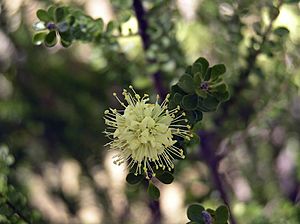Leionema rotundifolium facts for kids
Quick facts for kids Leionema rotundifolium |
|
|---|---|
 |
|
| Scientific classification | |
| Genus: |
Leionema
|
| Species: |
rotundifolium
|
Leionema rotundifolium is a type of bushy plant, or shrub. It has stems that look a bit like needles and pretty flowers that are pale yellow or white. You can find this plant growing in parts of New South Wales and Queensland in Australia.
What It Looks Like
Leionema rotundifolium is a thick, bushy shrub. It can grow up to 2 m (6 ft 7 in) (about 6.5 feet) tall. Its stems are round and smooth, and they are covered with tiny, star-shaped hairs.
The leaves are flat and feel a bit like leather. They are usually egg-shaped or almost round. Each leaf is about 0.6–1 cm (0.24–0.39 in) long and 4–6 mm (0.16–0.24 in) wide. They often overlap each other along the stems. The edges of the leaves are smooth or have very tiny bumps near the rounded tip.
The flowers grow in a round bunch at the top of the plant. These clusters are called an inflorescence. Each flower has a small cup-like part at its base called a calyx. This calyx is smooth and shaped like an upside-down cone.
The petals of the flowers are white to pale yellow. They are about 4–6 mm (0.16–0.24 in) long and have tiny dots on them. This plant usually flowers from late winter through spring. After flowering, it produces a dry fruit that is about 4–6 mm (0.16–0.24 in) long and has a small, pointed tip.
How It Got Its Name
This plant was first studied by a botanist named Allan Cunningham. He gave it the name Eriostemon rotundifolius. However, he didn't officially publish his description of the plant.
Later, in 1837, another botanist named Stephen Endlicher published Cunningham's description. Then, in 1998, Paul G. Wilson changed the plant's name to Leionema rotundifolium. He published this new name in a scientific journal called Nuytsia.
Where It Lives
Leionema rotundifolium grows in specific areas of Australia. You can find it in the Torrington and Howell areas of north-eastern New South Wales. It also grows near Glen Aplin in south-east Queensland.
This shrub prefers to grow on granite outcrops. These are places where large rocks made of granite stick out of the ground.

